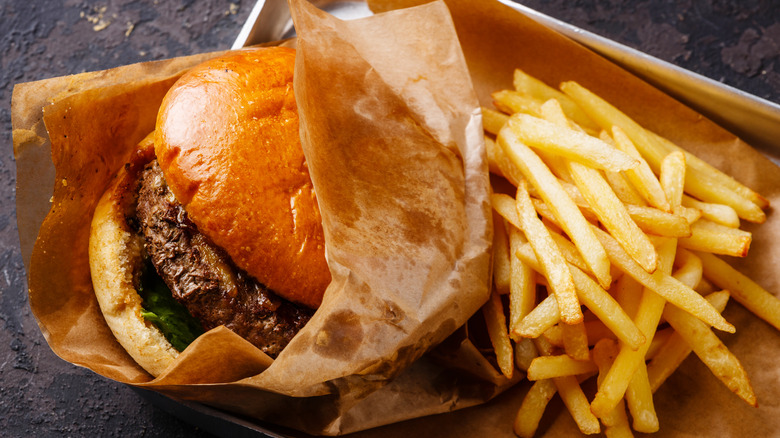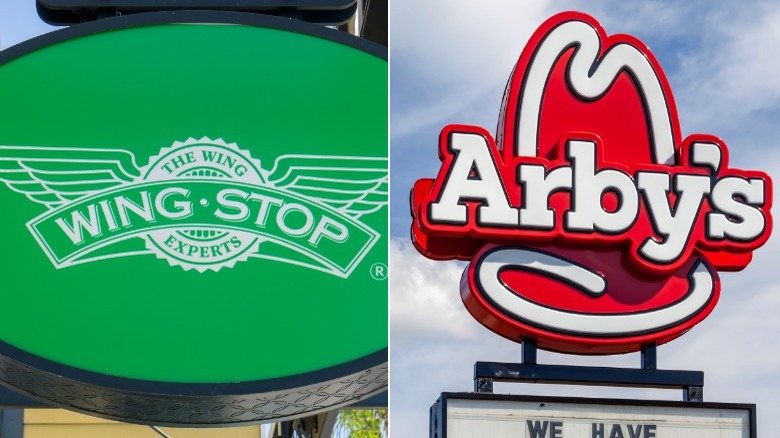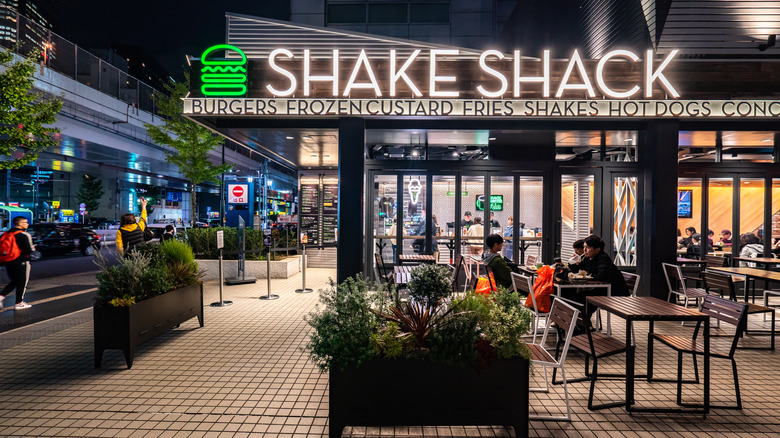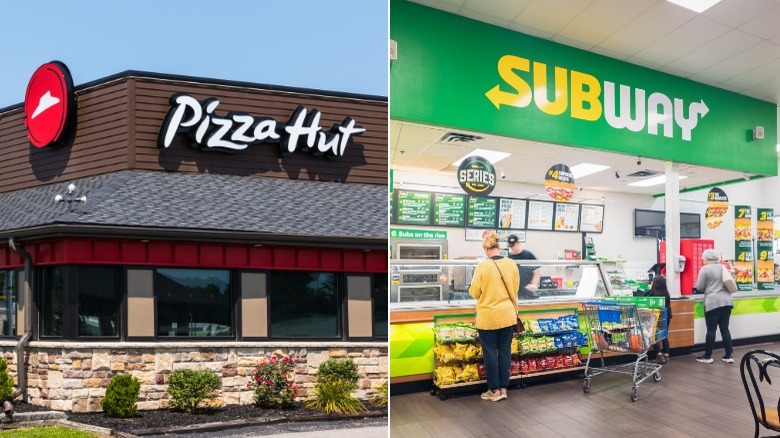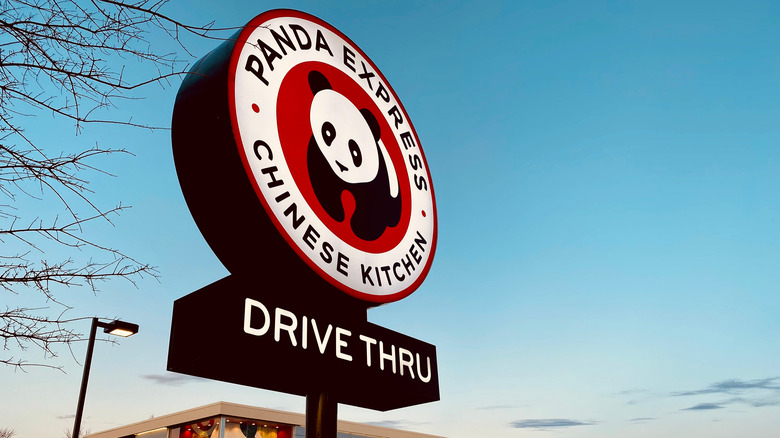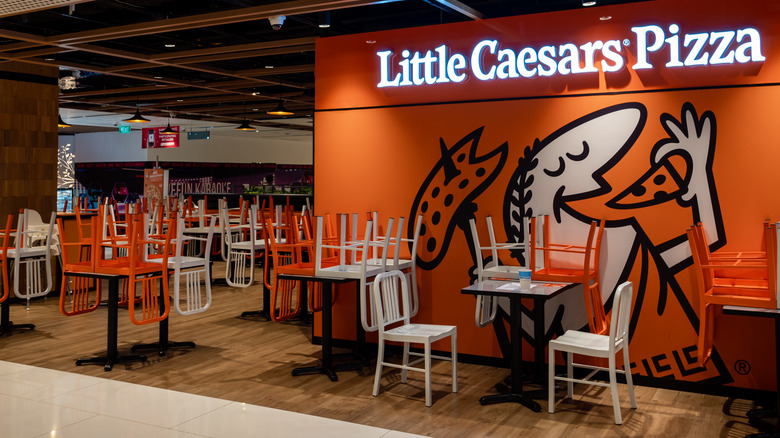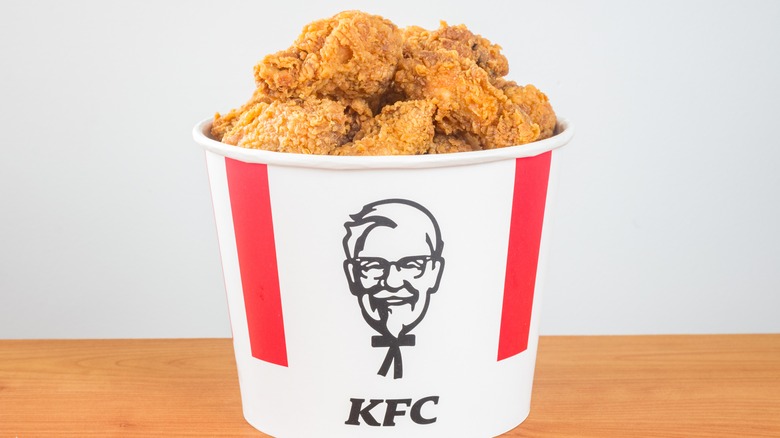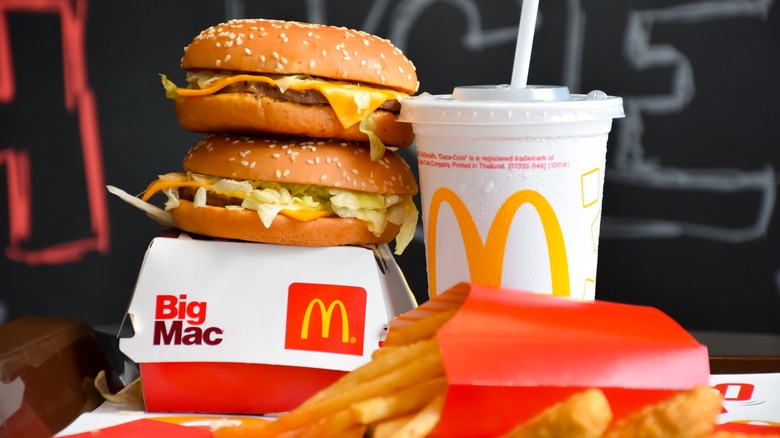The Most Popular Fast Food Restaurants The Year You Were Born
The fast-food restaurants lining the highway today likely aren't the same ones your parents frequented the year you were born. The popular chains then can give an idea of the grander scheme of things — the economy, culture, diet, and lifestyle of people at that time.
The first quick-service chains started as urban hamburger and soda stands in the 1920s. Owners followed Henry Ford's footsteps, making more consistent meals by basing their kitchen procedures on assembly lines. Then, in the '50s and '60s, people started moving out of cities, so suburban drive-ins became popular. Over the years, chains have spread dishes like fried chicken, tacos, frozen custard, pizza, and orange chicken to new areas. These recipes loosely represented a group of immigrants or a U.S. cultural region, but today they are familiar to the wider public.
The popularity of one chain over another also shows something about habits — in the '90s, health-conscious consumers preferred veggie-laden sandwiches over hamburgers and fries. Then, after 2000, different chains became popular because of their commitment to local communities. Some even invited guests to linger instead of getting diners in and out of the doors as quickly as possible. Take a look at the restaurant that was popular the year you were born, and you'll see a snapshot of the bigger picture.
2014 - 2017: Wingstop and Arby's
In recent years, Wingstop and Arby's have become increasingly popular. Wingstop is a newer chain, founded in 1994. Conversely, Arby's is one of the older names in the game, having originated in 1964. In the mid-2010s, these chains were thriving. Wingstop was expanding at break-neck speed, while Arby's bounced back from years of low sales and closures.
Wingstop, specializing in delivering wings, went public in 2015. Since then, this chain expanded the number of storefronts from around 900 to nearly 2,000 currently. News stories from around the U.S. announced the grand openings of new franchises. People seem to love how easy it is to order and get delivery through the app — over 60% of sales were digital in 2022. Some consumers lamented uneven service and quality from store to store, though. If Wingstop can work this kink out, the chain will be here to stay.
Arby's is already huge, with over 3,000 locations. After nearly 60 years in the business, Arby's has got to keep customers' attention with new offerings, like the Wagyu Burger. Between 2008 and 2010, the chain suffered from dropping sales and began closing locations. This continued until management hired CEO Paul Brown, who redid the menu, adding something new each month. In 2013, his team introduced the brisket sandwich, which improved sales by 12% singlehandedly. He also added novel items like a venison sandwich. Since then, the chain regained stability, remaining great.
2010 - 2013: Shake Shack
In 2010, Nation's Restaurant News named Shake Shack a "hot concept." The brand started as a temporary hot dog stand in Madison Square Park in 2001. It was an accessory to a piece of installation art called "I Heart Taxis." To make the exhibit realistic, the stand offered real food — hot dogs, homemade potato chips, lemonade, and rice crispy treats. It was so successful that patrons demanded it become permanent once the art display ended. Then, it attracted crowds so large that people would wait as long as three hours for a hamburger. A decade later, the owners expanded — at first in New York City and then to other cities around the world. The height of this was in the early 2010s.
Today, Shake Shack has just over 400 locations around the world, making it much smaller than many other chains. It has a high profile, though, due to its locations in places like John F. Kennedy International Airport and the Las Vegas Strip. The chain is famous for its dedication to becoming part of local communities, maintaining exceptional quality, and responsibly sourcing ingredients. Shake Shack is giving fast food a facelift.
2006 - 2009: Panera and Quiznos
Panera Bread and Quiznos Subs both started in the 1980s, began expanding in the '90s, and experienced a period of exponential growth in the mid-2000s. By the end of 2006, Panera began offering pizzas to expand the evening menu and had just passed 1,000 shop units. These locations were different from other fast-food restaurants because their buildings were designed to make people gather and linger there. Over the years, this marketing point has worked, as the chain has continued to grow and, currently, has doubled the number of locations it had in 2006.
Quiznos's story is not so bright. In 2007, this chain was at the peak of its expansion — it had over 4,600 franchises and was stiff competition for Subway. Success lasted only briefly, though. Despite the popularity of its scrumptious toasted sandwiches, many of its stores had low sales. High food costs cut into the profits of franchisees, who became increasingly angry with the company. Just 10 years later, Quiznos had lost more than 90% of its storefronts, leaving 374. The chain is still around today, though, and is cautiously starting to grow again.
2002 - 2005: Domino's
Domino's Pizza was already a giant in 2002 – 13 years earlier, the chain opened its 5,000th shop. The early 2000s marked a particularly fruitful time for the company, though. In 2002, Domino's earnings increased by around 17%, which the company attributed to an increase in quality and customer service over four years straight, as judged by the American Customer Satisfaction Index. By the end of 2003, the company had 7,427 locations. In the same year, the pizza delivery specialist received an honor from Pizza Today Magazine: They named Domino's the chain of the year for the first time. Then, in 2004, Domino's became a publicly traded company.
Today, Domino's is still going strong. They won two more chain of the year awards, in 2010 and 2011 after changing their recipe. Then, the chain started using special delivery vehicles equipped with a heating oven, and later they added an electric fleet. Now, Domino's is developing self-driving delivery cars. They've lost some locations since the early 2000s, though — by 2018, they were down to around 5,900 storefronts, but remain firmly among the 10 most popular fast food providers.
1998 - 2001: Culver's
Today, Culver's is on the NRN's list of the 50 most successful fast food chains. Things weren't always this way – when Craig Culver opened the first one in his Wisconsin hometown in 1984, it took two years to see a profit. The first time he sold a franchise, it was a flop. Neither experience deterred him.
His company was on the fast track by the late '90s. In 1999, Culver's reported sales greater than $100 million for the first time. Then, in 2000, it opened its 100th location. More importantly, Culver had trained more than 100 owner-operators to make the restaurant's specialty: frozen custard. Early on, friends had warned him that this recipe was too difficult to replicate in other branches and that people outside of Wisconsin wouldn't understand what frozen custard was. Culver paid little heed and he personally trained his franchisees to make the dessert. Now, nearly 700 storefronts draw in customers with the treat, which differs from ice cream in that its recipe includes eggs.
1994 - 1997: Pizza Hut and Subway
The '90s were an era of extreme advertising. The success of Pizza Hut and Subway in this decade is due to how they introduced new products and then presented them to the world through commercials.
Subway was already well-established in the '90s — three decades earlier, Dr. Peter Buch, a nuclear physicist funded the original shop, an idea of one of his proteges, Fred DeLuca. At the time, DeLuca needed help paying for his education, so he turned to selling sandwiches. Around 30 years later, in 1990, the company opened its 5,000th franchise. It's safe to say that DeLuca was no longer hurting for money. Then, in 1997, the chain drew even more business when it came out with its seven low-fat subs campaign – Subway appealed to health-conscious consumers. In the years to come, Subway surpassed McDonald's in the number of locations, though not in earnings.
Pizza Hut held around 25% of the pizza market in the mid-'90s and easily won against competitors like Little Caesars and Domino's because of their new product development. In these years, the pride of their restaurants and the king of their commercials was the stuffed crust pizza. This single, new product garnered over $1 billion in sales in 1995 when it came out. It raised the company's stock by about 50%.
1990 - 1993: Panda Express
Today, Panda Express is the largest chain of Chinese-American restaurants in the U.S., but things weren't always this way. The company started with just one location in a California mall food court in 1983. The restaurant was singular in that it adapted Chinese food to the American palette — traditional recipes lost some of their spices and the food was fast-serve.
In 1990, Panda Express had just 50 locations, but in the next five years, they expanded to around 100. This was due to original recipes like orange chicken, fantastic management, and the application of point-of-sale terminals by owner and computer scientist Peggy Cherng. This was one of the first times a business would track inventory and customer behavior using computer analytics to make the supply chain more efficient.
1986 - 1989: Wendy's
In the early '80s, Wendy's already had more than 2,000 locations around the U.S., but 1986 was terrible for Wendy's. The year before, they'd had record sales, but an ill-fated breakfast menu and corporate corner-cutting got the company in trouble. They lost $4.9 million worth of business and 20% of their franchises were near bankruptcy just 12 months after those high numbers.
Dire situations bring out the best and worst in organizations — here, Wendy's proved itself by hiring Jim Near as president. The executive ensured that Wendy's restaurants were consistent across the country — each franchise must follow specific cooking methods and demonstrate sparkling cleanliness. He also added smaller burgers and skinless chicken breast sandwiches to the menu. By 1989, Near's guidance brought the company's sales up by a huge 25% when he discounted seven menu items, appealing to younger patrons.
Wendy's thrived and changed in the late '80s. These were years that could have brought collapse, but effective management made them brilliantly successful.
1982 - 1985: Burger King
Burger King found its identity and set a path for itself in the '80s. The '70s had been a tough time — loose franchising agreements gave owners too much power. Burger Kings varied in quality from one region to another, but people like chains because they can depend on a product to always be the same. Burger King did not fulfill this expectation, and so the company suffered. It spent the late '70s getting wild franchisees under control and once achieved, the path was clear for unhampered growth in the '80s.
In this decade, Burger King achieved consistency, making its restaurants more dependable. The chain also introduced French toast sticks and the Croissan'wich for breakfast, leading to larger sales and greater popularity. Burger King rose in the ranks, taking second place only to McDonald's. Sales grew to more than $1 million per location in 1985.
1978 - 1981: Little Caesar's
Little Caesar's is famous for three things: Detroit-style pizza, its amateur hockey league, and the catchphrase, "Pizza! Pizza!" The latter two of these came about in 1979.
When the young couple, Mike and Marian Ilitch, opened their first carry-out pizza restaurant, the idea was novel. From the first, they drew in business with memorable advertising and cheap fare. The first example of this was a sketch of a tiny Caesar saying, "Pizza! Pizza!" It meant that patrons of the pizza joint could get two pizzas for the price of one from a competing restaurant. In the late '70s, the chain also started using an innovative pizza conveyor belt oven to speed up production while lowering costs.
In 1979, there were only around 50 Little Caesar's locations operating. The commercials worked brilliantly, despite being astonishingly simple, and in the '80s, the chain grew to 226 storefronts. In the '90s, there were over 1,000. Today, Little Caesar's is the third largest pizza chain, behind only Domino's and Pizza Hut.
1974 - 1977: A&W
There aren't many chains that can say they're a century old, but A&W is one of them. It grew from a stand that sold ice-cold, homemade root beer at a parade in 1919. The business evolved into a chain of franchised drive-in restaurants.
The '70s were a booming time for A&W — most franchisees had signed their 20-year contracts with the company in the '50s and '60s. These businesses remained open and, in 1974, the chain had 2,400 restaurants across the U.S. These locations were each unique, though — owners had been granted room for creativity. Their menus could vary, as could the color of the paint on the outside of the restaurants. A road trip along Route 66 in the early to mid-'70s would likely have taken travelers past more than one A&W.
Things changed, though. A larger Interstate Highway System drew patrons away from once-busy restaurant locations – in 1979, the American Association of State Highways and Transportation Officials declared that Route 66 was no longer a national highway. At around the same time, A&W's franchise contracts started coming up for renewal. The company, hoping for greater uniformity like that demonstrated by McDonald's, made these stricter. Restaurant owners balked and the chain shrank to only 500 restaurants in the early '80s. Today, A&W is still around, but perhaps not as it was in its heyday.
1970 - 1973: Taco Bell
People love tacos, but there was a time when they were not so widely known across the continental U.S. That's to say, you could divide time into pre-Taco Bell and post-Taco Bell.
Glen Bell got his recipe for hard-shell tacos around the year 1950 from the bustling Mexican restaurant Mitla Cafe, located across the street from his struggling hamburger stand. When he added tacos to his menu, business grew. Then, Bell figured out how to mass-produce the crunchy entrees, making them fast food.
Twenty years later, in 1970, Taco Bell became a publicly traded company and had more than 300 locations. During this decade, the chain continued expanding, bringing its Mexican-inspired cuisine to people much farther from the border than where it got its start in San Bernadino, California.
1962 - 1969: KFC
Colonel Harland Sanders only experienced success after he retired. Just before this, he closed and auctioned off his struggling restaurant for less than it was worth, leaving him financially hurting. He and his wife were looking at spending their golden years carefully minding their pennies. That's when, at age 66, the couple decided to journey across the country, selling Sanders' chicken preparation procedure as a franchise. In 1956, restaurants that wanted to serve his chicken paid him four cents for every bird cooked with his method. By 1963, 600 restaurants were selling Sander's chicken as a part of their menus.
Things change quickly, and it was no different for KFC in the early '60s. Businessmen saw potential in Sanders' chicken and pushed him to sell his idea in 1964 when he was 74. After that, KFC stopped selling franchises to restaurants and opened free-standing take-out shops that only sold chicken. In fewer than 10 years, the chain expanded to 2,700 locations. Today, KFC continues to thrive, selling its chicken in over 4,000 restaurants.
1954 - 1961: McDonald's
Around one-third of all U.S. restaurant visits are to a McDonald's — that's nearly triple the number of its next competitor. It's been the most popular fast food since the '80s. Even before that, McDonald's had already captured the country's attention and changed the food industry. McDonald's initial success in the mid-'50s impacted how restaurants would prepare food for decades afterward. Other chains imitated the high-efficiency model perfected in these kitchens.
The McDonald brothers set up a successful business based on making uniform hamburgers and shakes quickly and cheaply. For example, they may have been the first to use heating lamps to keep French fries warm. Everything else in their kitchens was streamlined, as well, to make them super efficient. They used eight shake-mixing machines — which could make 48 shakes at once in one of their seven California drive-ins. That drew the attention of the man selling the appliances — no other restaurant had made such a big order for a single location. Since the brothers were looking for a franchising agent, he asked for the job and got it.
The new franchising agent, who would buy out the company around a decade later, set up 228 suburban franchises in the mid-'50s and introduced Ronald McDonald to attract families. Since that time, McDonald's has grown to become the most popular and highest-grossing fast food chain in the United States, in part due to its sheer size — it has around 13,500 locations.
1950 - 1953: White Castle
You probably wouldn't eat nearly as many hamburgers if it hadn't been for White Castle. Early in the 20th century, hot meat sandwiches had a bad reputation and weren't particularly popular. People doubted this street food — they didn't know how clean the preparation area was and or what ingredients got mixed in the meat.
In the '20s and '30s, the founders of White Castle dispelled this common perception by insisting that all employees dress in impeccably clean white uniforms. They ground their meat where customers could see and built restaurants with white porcelain steel, which lent itself to the company's desired squeaky-clean image. Finally, they made their hamburgers uniform from store to store and used an assembly-line procedure to cook them. This set the stage for all other fast-food chains to come.
In the early '50s, White Castle was thriving, with people forming long lines at its locations in big cities. It had little competition until McDonald's overtook it in the '60s. Then, the chain adapted too slowly to suburbanization, while the competition embraced it. Today, White Castle still has around 375 locations and remains in the same family.
